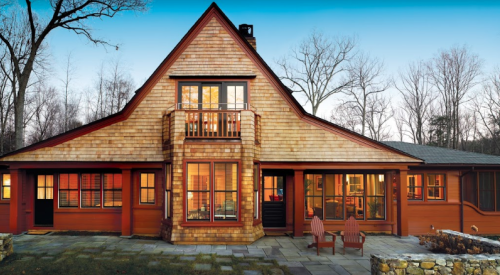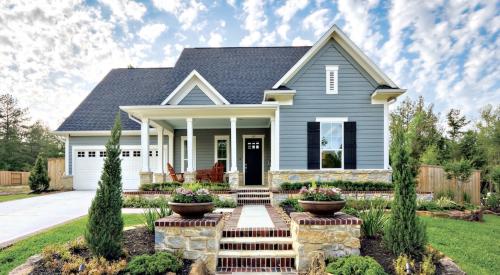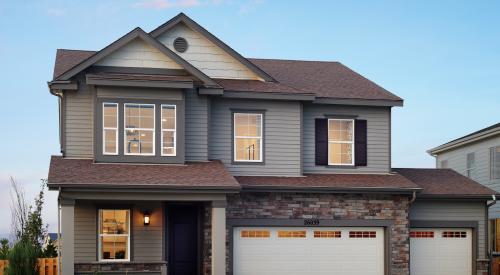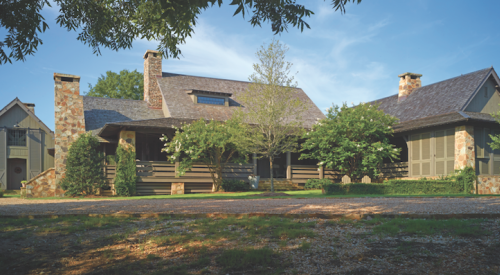Think back to the moldings and trim you might have had in your home while growing up. Now compare that with the options and uses of those elements today, and it's easy to see why many home buyers are eager to include moldings and trim in their homes.
"Most of us grew up in an age when moldings only did things like cover the gap between the doorframe and the wall," says Carl Christoferson, manager of West Coast sales for molding and millwork manufacturer Windsor Mill. Now, paying heed to the possibilities of moldings and trim not only can satisfy customers but also can prove to be a financial boon to builders. "The perceived value of moldings and trim creates a higher perceived value of a home," Christoferson says. "Builders can put that in their pocket as profit or pass it along as an added value."
|
The addition of a ceiling medallion around a light fixture adds an elegant touch to the formal rooms of a house, such as a living or dining room.
|
According to a 2000 NAHB survey of consumers who had bought a home in the past two years or planned to buy one during the next two years, 41% of respondents "desired" crown ceiling molding, and 4% considered it "essential." Crown molding was particularly popular among higher-income groups seeking more expensive homes and somewhat more popular in the South Atlantic and South Central regions than in other parts of the country.
John Choate, president of Choate Custom Homes in Milford, Mich., says, "Some clients just want one crown molding, and others want a style, either an architectural style or a period reproduction. We're winning business from clients who have gone to other builders that were not as up to speed on moldings and trim. There are a lot of good builders. If my game is better than theirs, we win more."
He's not alone.
"Trim can often be the primary detail piece that people see when they first come into a home," says Mariane Erickson, production coordinator at Sattler Homes, a custom builder in Greenwood Village, Colo. "That's what people notice, how ornate or simple even the casings around the windows are."
Myriad Choices
The molding spectrum runs from plain architectural details to the totally ornate. "If people want an English style, they'll select a heavy, detailed molding, or they might want to stick with a more contemporary, clean-cut, simple molding," says Stefania Mittica, a designer for Canadian manufacturer Classic Mouldings.
Home buyers often like to display their tastes in what Steve Roth, technical adviser for Style Solutions, calls "visibility rooms. You see trim details most in family rooms and living rooms."
Erickson calls living rooms a primary target for moldings and trim because "they tend to be more formal and therefore more elaborately finished than more casual rooms, like the family room."
But other buyers pay particular attention to places such as foyers and kitchens, "areas where they're going to be entertaining and want architectural accents," says Choate, whose company also has installed moldings and trim in master bedrooms and master baths.
Differentiation = Dollars
Moldings and trim can help differentiate your homes from those of your competitors, notes Hans Schulz, national sales manager for Flex Trim and a former builder. "People look for things that are unique, that set their home apart, even if only by a fraction of a degree, like extra detailing on casings or a little more ornate molding," he says. "It might not so much be a stain-grade molding, but a profile that's unique to them."
This can be accomplished in several ways, says Tom Kawesza, vice president of sales and marketing at manufacturer M.L. Condon Co. "If someone wants cherry, you can go traditional American cherry, but there now are inroads on other cherries, such as jatoba, a form of Brazilian cherry," he says. "Same goes for walnut. Buyers want diversity within price points."
Diversity can spell value. "New home buyers expect base molding," Roth says, "but as soon as a builder adds crown moldings, moldings around doors and windows, anything that helps set them off, the buyer recognizes the value. Smart builders know this helps set their homes apart."
|
This Classical Craftsman room set uses thicker moldings and trim to create a bold look.
|
Remember, consumers will pay for extras. "In the 1960s, for instance, you'd go to two different developments on either side of one street," Schulz recalls. "The houses could be exactly the same, but one builder might have put in a dishwasher and priced his home $5,000 more than the other. His would sell faster." The same principle applies to moldings and trim. "It's the extra features that can add to a home's value," Schulz says.
Consumers also value low maintenance, a feature that Style Solutions touts in its urethane millwork. "When you're looking at urethane moldings and trim," Roth says, "you're looking at products that don't warp, chip, rot or decay, and that resist termites and insects, so they can be used inside and outside. Whether a builder installs them in a coastal area that gets strong salt air and sea spray, in mountainous areas that have extreme cold, or in high-humidity areas like the South, none of those elements impacts these urethane products."
Sattler Homes uses wood trim and moldings primarily, but Erickson appreciates what composite materials offer. "We can do more with composites," she says. "When trying to trim around a dome, it's pretty hard to get wood to bend, unlike a synthetic material that's engineered to flex. But our buyers still want certain woods for moldings. They're looking for that richness they can't necessarily get with a composite."
Period Pieces
Many buyers insist on historically correct moldings and trim, and Mittica thinks some builders are more responsive to that than others. "Sometimes they just want to save a buck and don't bother, and if some homeowners don't know the difference, it won't matter," Mittica says. "Home buyers who might not be historically inclined might not know if the molding is historically accurate."
Christoferson thinks they're missing something. His company's WindsorONE line comprises Classic Colonial, Greek Revival, Classical Craftsman and Colonial Revival moldings. "When you apply architectural ideals into a home," he says, "you create a feeling, and that feeling works when you're going to sell a home."
Interiors and exteriors both count in home sales. While Kawesza says M.L. Condon finds that interior moldings and trim are more popular, "exteriors are done also, whether in pool areas, porch decking or support ceiling moldings, or now with exquisite balusters and trimmings and shaped handrails. A lot of moldings and trim go exterior."
There they deliver curb appeal. Schulz estimates that Flex Trim's exterior business has climbed 15% during the past three to five years "primarily because of curb appeal. Curb appeal sells. People are going for things like crowns - anything subtle but striking."
Nevertheless, Christoferson says, some builders, particularly production builders, seem reluctant to stray from the moldings and trim norm. "Sometimes the status quo is easier than breaking outside the box," he says. "Builders who distinguish themselves by using custom moldings and trim are going to be more successful. People walk into a home and have such an emotional connection and reaction once it's installed that they think their builder is the best."










